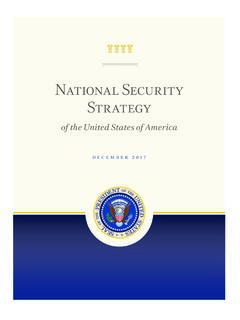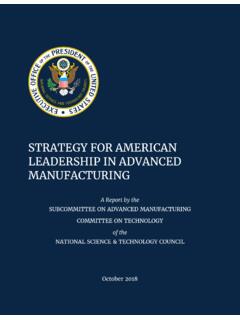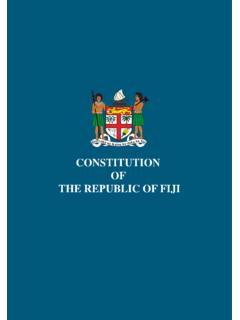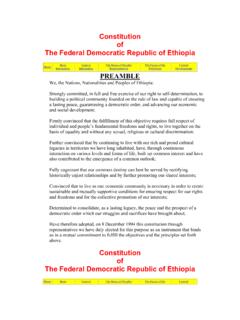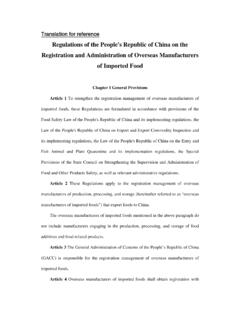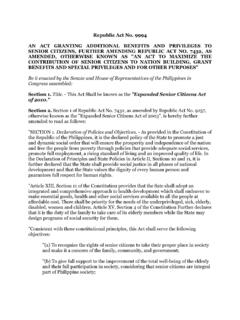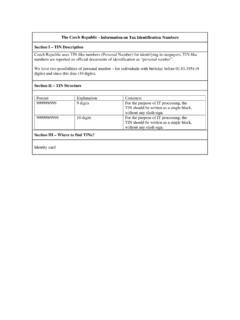Transcription of United States Strategic Approach to the People’s Republic ...
1 Introduction Since the United States and the people s Republic of China (PRC) established diplomatic relations in 1979, United States policy toward the PRC was largely premised on a hope that deepening engagement would spur fundamental economic and political opening in the PRC and lead to its emergence as a constructive and responsible global stakeholder, with a more open society. More than 40 years later, it has become evident that this Approach underestimated the will of the Chinese Communist Party (CCP) to constrain the scope of economic and political reform in China. Over the past two decades, reforms have slowed, stalled, or reversed. The PRC s rapid economic development and increased engagement with the world did not lead to convergence with the citizen-centric, free and open order as the United States had hoped. The CCP has chosen instead to exploit the free and open rules-based order and attempt to reshape the international system in its favor.
2 Beijing openly acknowledges that it seeks to transform the international order to align with CCP interests and ideology. The CCP s expanding use of economic, political, and military power to compel acquiescence from nation States harms vital American interests and undermines the sovereignty and dignity of countries and individuals around the world. To respond to Beijing s challenge, the Administration has adopted a competitive Approach to the PRC, based on a clear-eyed assessment of the CCP s intentions and actions, a reappraisal of the United States many Strategic advantages and shortfalls, and a tolerance of greater bilateral friction. Our Approach is not premised on determining a particular end state for China. Rather, our goal is to protect United States vital national interests, as articulated in the four pillars of the 2017 National Security Strategy of the United States of America (NSS). We aim to: (1) protect the American people , homeland, and way of life; (2) promote American prosperity; (3) preserve peace through strength; and (4) advance American influence.
3 Our competitive Approach to the PRC has two objectives: first, to improve the resiliency of our institutions, alliances, and partnerships to prevail against the challenges the PRC presents; and second, to compel Beijing to cease or reduce actions harmful to the United States vital, national interests and those of our allies and partners. Even as we compete with the PRC, we welcome cooperation where our interests align. Competition need not lead to confrontation or conflict. The United States has a deep and abiding respect for the Chinese people and enjoys longstanding ties to the country. We do not seek to contain China s development, nor do we wish to disengage from the Chinese people . The United States expects to engage in fair competition with the PRC, whereby both of our nations, businesses, and individuals can enjoy security and prosperity. Prevailing in Strategic competition with the PRC requires cooperative engagement with multiple stakeholders, and the Administration is committed to building partnerships to United States Strategic Approach to the people s Republic of China 2 protect our shared interests and values.
4 Vital partners of this Administration include the Congress, state and local governments, the private sector, civil society, and academia. The Congress has been speaking out through hearings, statements, and reports that shed light on the CCP s malign behavior. The Congress also provides legal authorities and resources for the United States Government to take the actions to achieve our Strategic objectives. The Administration also recognizes the steps allies and partners have taken to develop more clear-eyed and robust approaches toward the PRC, including the European Union s publication in March 2019 of EU-China: A Strategic Outlook, among others. The United States is also building cooperative partnerships and developing positive alternatives with foreign allies, partners, and international organizations to support the shared principles of a free and open order. Specific to the Indo-Pacific region, many of these initiatives are described in documents such as the Department of Defense June 2019 Indo-Pacific Strategy Report and the Department of State November 2019 report on A Free and Open Indo-Pacific: Advancing a Shared Vision.
5 The United States is working in concert with mutually aligned visions and approaches such as the Association of Southeast Asian Nation s Outlook on the Indo-Pacific, Japan s free and open Indo-Pacific vision, India s Security and Growth for All in the Region policy, Australia s Indo-Pacific concept, the Republic of Korea s New Southern Policy, and Taiwan s New Southbound Policy. This report does not attempt to detail the comprehensive range of actions and policy initiatives the Administration is carrying out across the globe as part of our Strategic competition. Rather, this report focuses on the implementation of the NSS as it applies most directly to the PRC. Challenges The PRC today poses numerous challenges to United States national interests. 1. Economic Challenges Beijing s poor record of following through on economic reform commitments and its extensive use of state-driven protectionist policies and practices harm United States companies and workers, distort global markets, violate international norms, and pollute the environment.
6 When the PRC acceded to the World Trade Organization (WTO) in 2001, Beijing agreed to embrace the WTO s open market-oriented Approach and embed these principles in its trading system and institutions. WTO members expected China to continue on its path of economic reform and transform itself into a market-oriented economy and trade regime. These hopes were not realized. Beijing did not internalize the norms and practices of competition-based trade and investment, and instead exploited the benefits of WTO membership to become the world s largest exporter, while systematically protecting its domestic markets. Beijing s economic policies have led to massive industrial overcapacity that distorts global prices and allows China to expand global market share at the expense of 3 competitors operating without the unfair advantages that Beijing provides to its firms. The PRC retains its non-market economic structure and state-led, mercantilist Approach to trade and investment.
7 Political reforms have likewise atrophied and gone into reverse, and distinctions between the government and the party are eroding. General Secretary Xi s decision to remove presidential term limits, effectively extending his tenure indefinitely, epitomized these trends. In his 2018 Findings of the Investigation into China s Acts, Policies, and Practices Related to Technology Transfer, Intellectual Property, and Innovation under Section 301 of the Trade Act of 1974, the United States Trade Representative (USTR) determined that numerous acts, policies, and practices of the PRC government were unreasonable or discriminatory, and burden or restrict United States commerce. Based on a rigorous investigation, USTR found that the PRC: (1) requires or pressures United States companies to transfer their technology to Chinese entities; (2) places substantial restrictions on United States companies ability to license their technology on market terms; (3) directs and unfairly facilitates acquisition of United States companies and assets by domestic firms to obtain cutting edge technologies; and (4) conducts and supports unauthorized cyber intrusions into United States companies networks to access sensitive information and trade secrets.
8 The list of Beijing s commitments to cease its predatory economic practices is littered with broken and empty promises. In 2015, Beijing promised that it would stop government-directed cyber-enabled theft of trade secrets for commercial gain, reiterating that same promise in 2017 and 2018. Later in 2018, the United States and a dozen other countries attributed global computer intrusion campaigns, targeting intellectual property and confidential business information, to operators affiliated with the PRC s Ministry of State Security a contravention of Beijing s 2015 commitment. Since the 1980s, Beijing has signed multiple international agreements to protect intellectual property. Despite this, more than 63 percent of the world s counterfeits originate in China, inflicting hundreds of billions of dollars of damage on legitimate businesses around the world. While Beijing acknowledges that China is now a mature economy, the PRC continues to argue in its dealings with international bodies, including the WTO, that it is still a developing country.
9 Despite being the top importer of high technology products and ranking second only to the United States in terms of gross domestic product, defense spending, and outward investment, China self-designates as a developing country to justify policies and practices that systematically distort multiple sectors globally, harming the United States and other countries. One Belt One Road (OBOR) is Beijing s umbrella term to describe a variety of initiatives, many of which appear designed to reshape international norms, standards, and networks to advance Beijing s global interests and vision, while also serving China s domestic economic requirements. Through OBOR and other initiatives, the PRC is expanding the use of Chinese industrial standards in key technology sectors, part of an effort to strengthen its own companies position in the global marketplace at the expense of non-Chinese firms. Projects that Beijing has labeled OBOR include: transportation, information and communications technology and energy infrastructure; industrial parks; media collaboration; science and 4 technology exchanges; programs on culture and religion; and even military and security cooperation.
10 Beijing is also seeking to arbitrate OBOR-related commercial disputes through its own specialized courts, which answer to the CCP. The United States welcomes contributions by China to sustainable, high-quality development that accords with international best practices, but OBOR projects frequently operate well outside of these standards and are characterized by poor quality, corruption, environmental degradation, a lack of public oversight or community involvement, opaque loans, and contracts generating or exacerbating governance and fiscal problems in host nations. Given Beijing s increasing use of economic leverage to extract political concessions from or exact retribution against other countries, the United States judges that Beijing will attempt to convert OBOR projects into undue political influence and military access. Beijing uses a combination of threat and inducement to pressure governments, elites, corporations, think tanks, and others often in an opaque manner to toe the CCP line and censor free expression.


